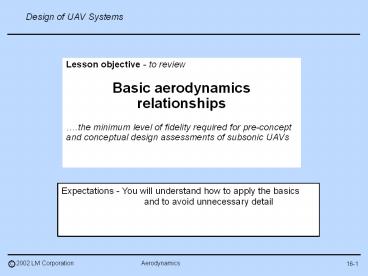Lesson objective - to review - PowerPoint PPT Presentation
1 / 14
Title:
Lesson objective - to review
Description:
the minimum level of fidelity required for pre-concept and conceptual design ... P and T = Total (isentropic stagnation) pressure and temperature ... – PowerPoint PPT presentation
Number of Views:122
Avg rating:3.0/5.0
Title: Lesson objective - to review
1
Lesson objective - to review Basic aerodynamics
relationships .the minimum level of fidelity
required for pre-concept and conceptual design
assessments of subsonic UAVs
Expectations - You will understand how to apply
the basics and to avoid unnecessary detail
16-1
2
Importance
These are the fundamental aerodynamic
relationships needed to define a subsonic air
vehicle for a UAV system
16-2
3
Forces
and geometry
Ct
16-3
4
Aerodynamic lift
Lift (L) Cl????q?Sref Cl?q?Sref (16.1)
Cl? lift curve slope (theoretrical 2??/rad
see RayAD Eq 12.6 for
more exact formulation) ? angle of
attack Sref aerodynamic reference area
Dynamic pressure (q) (?/2)?V2
(16.2) ? air density (lb-sec2/ft4) V
airspeed (ft/sec)
where
and
where
For uncambered airfoils Cl 0 at ? 0
?
V
16-4
5
Aerodynamic drag
Drag (D) Cd?q?Sref
(16.3) Cd drag coefficient
CdminCdi Cdmink?Cl-Clmin2 (16.4) k
1/??A?e A Aspect ratio b2/Sref e Oswold
wing efficiency f(?,A) ? sweep Cdmin
Cf?Kd?(Swet/Sref) Cfe?(Swet/Sref)
(16.5) Cf flat plate skin friction coefficient
(See RayAD Fig 12.21) Kd ? 1.2
Factor to account for non-friction drag items
such as pressure and interference) Cfe
Equivalent skin friction coefficient (RayAD12.3)
where
and
For uncambered airfoil Cdmin Cd0
where
- These relationships are for untrimmed drag
polars, good aerodynamic design will minimize
trim drag impact (which we will ignore for now)
16-5
6
Oswold efficiency factor
Source - Lee Nicolai, Conceptual Design Process,
LM Aero
16-6
7
Lift and drag - contd
- CL? and Cdmin are approximately constant for
low-to-medium subsonic speed range (below drag
rise) - This simplifying assumption makes our aero
analysis task really easy (and reasonably correct)
16-7
8
L/D max - another perspective
- Theoretical (L/D)max
- If Cd Cd0 K?Cl2 then D/L Cd0/Cl K?Cl)
and (L/D) max will occur when d(D/L)/dCl 0 - - Cd0/Cl2 K 0 or Cd0 K?Cl2 Cdi
or.
16-8
9
L/D contd
16-9
10
Example
A subsonic UAV has the following
characteristics W0/Sref 40 psf AR 20 ? 0
deg Swet/Sref 5 or b2/Swet 20/5 4 Cfe
.0035 From chart 16.6 at AR 20 and ? 0 deg, e
0.8 and Cd _at_ LoDmax 2?Cfe?(Swet/Sref)
.035 Cd0 .0175 Cl _at_ LoDmax sqrt (??AR?e?Cdo)
0.938 LoDmax sqrt??e/Cfe?AR/(Swet/Sref)/
2 26.8 q _at_ LoDmax (W0/Sref)/Cl 42.6 psf EAS
_at_ LoDmax 112.2 KEAS
16-10
11
Correction factors
- For pre-concept studies, equations 16.1 - 16.5
will yield reasonable estimates of lift and drag - Nonetheless it is good practice to always compare
estimates to data from similar aircraft and to
apply appropriate correction factors
- Our previous calculation of LoDmax 26.8 for AR
20, Swet/Sref 5, for example, when compared
to parametric data from other aircraft shows that
our estimate is consistent with the parametric
data - If not we could correct the estimate by putting a
multiplier on Cdmin
LoDmax comparisons
35
30
25
20
(L/D)max
15
10
5
0
0
2
4
6
8
Wetted AR b2/Swet
Manned aircraft data LM Aero data handbook
16-11
12
More refined estimates
- For conceptual design studies, a component
build-up method (see RayAD 13.5) will yield
higher fidelity drag estimates and capture - Reynolds number effects
- Overall and for individual components
- Form factor effects
- Such as wing thickness
- Interference drag effects
- Miscellaneous drag contributions
- As we will see later, our pre-concept design
spread sheet methods could also incorporate these
higher fidelity methods with little additional
work - They will be included at a later date
- A better approach for conceptual design, however,
would be a combination of component build up for
trade studies and Euler CFD for baseline analysis
16-12
13
Compressibility effects
On subsonic UAVs we can ignore compressibility
effects for lift and drag, but not for jet engine
performance - The effects are estimated assuming
a perfect gas, where specific heat ratio (?
1.4) Pressure effect P/Pa 1(?-1)/2?M2?/(
?-1) 10.2?M23.5 (16.11) Temperature
effect T/Ta 1(?-1)/2?M2 10.2?M2
(16.12) P and T Total
(isentropic stagnation) pressure and
temperature Pa and Ta Static atmospheric
pressure and temperature Example M 0.8
36Kft (Pa 472.6 psf Ta 390R) P/Pa 1.52 or
P 720 psf ( 27Kft _at_ M0) T/Ta 1.13 or T
440R -19.8F ( 22Kft _at_ M0)
where
16-8
14
Intermission
16-8































